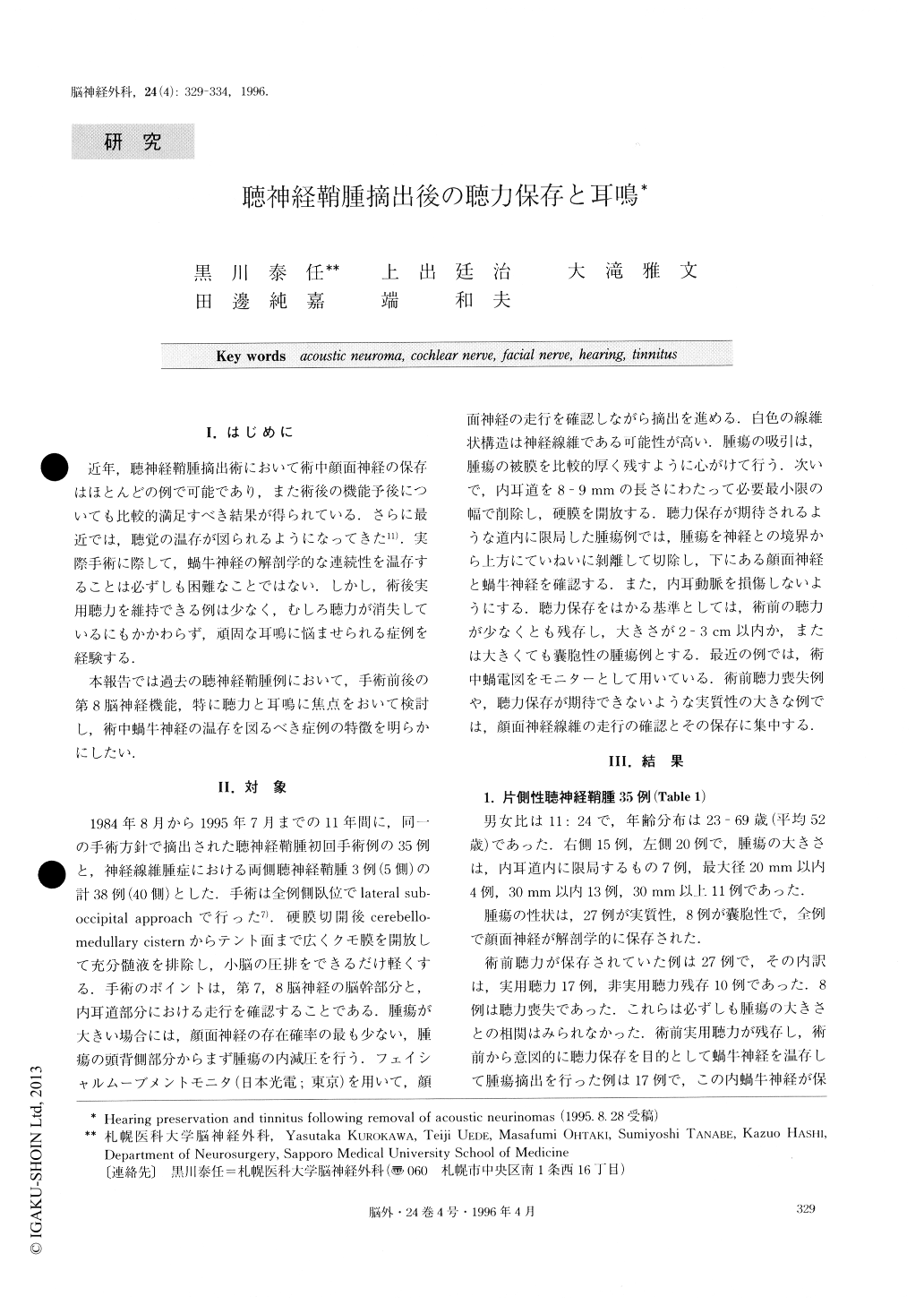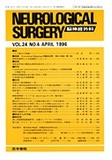Japanese
English
- 有料閲覧
- Abstract 文献概要
- 1ページ目 Look Inside
I.はじめに
近年,聴神経鞘腫摘出術において術中顔面神経の保存はほとんどの例で可能であり,また術後の機能予後についても比較的満足すべき結果が得られている.さらに最近では,聴覚の温存が図られるようになってきた11).実際手術に際して,蝸牛神経の解剖学的な連続性を温存することは必ずしも困難なことではない.しかし,術後実用聴力を維持できる例は少なく,むしろ聴力が消失しているにもかかわらず,頑固な耳鳴に悩ませられる症例を経験する.
本報告では過去の聴神経鞘腫例において,手術前後の第8脳神経機能,特に聴力と耳鳴に焦点をおいて検討し,術中蝸牛神経の温存を図るべき症例の特徴を明らかにしたい.
Thirty-five cases of unilateral acoustic neurinomas were analyzed with special reference to the postopera-tive eighth cranial nerve function. An additional three cases of bilateral acoustic neurinomas associated with neurofibromatosis were also analyzed. Out of a total of 40 neurinomas in all, 38 cases were retrospectively re-viewed.
The thirty-five cases of unilateral acoustic neurino-mas were summarized as follows. The patients' age ranged from 23 to 69 years old. The tumor size varied as follows; 7 cases were confined to the internal acous-tic meatus, 4 cases were 20 mm or less in their max-imum diameter, 13 cases were 30 mm or less, and 11 cases were more than 30 mm. The consistency of the tumor was classified as being solid in 27 cases, and being cystic in 8 cases. Hearing had been maintained in 27 cases on admission, serviceable in 17 cases, unser-viceable in 10 cases and deaf in 8 cases. Operations were performed via the retromastoid suboccipital approach in all cases. The facial nerve was anatomical-ly preserved in all cases. On the other hand, the coch-lear nerve was anatomically preserved in 14 out of 35 cases (40%). The preservation ratio of the cochlear nerve showed a negative correlation to the tumor size. In 17 cases with preoperative serviceable hearing, preservation of the cochlear nerve was attempted, which resulted in a 65% anatomical preservation. However, hearing was preserved in 4 cases (36%). Ser-viceable hearing was preserved in only 2 cases. Tinnitus developed in 20 cases preoperatively, and then occurred postoperatively in 11 cases. Tinnitus was prominently aggravated in 2 cases in which the coch-lear nerves were preserved, which resulted in unser-viceable hearing. There was a statistically significant correlation between cochlear nerve preservation and the postoperative presence of tinnitus (Fisher's exact probability test: P=0.0106<0.05). Tinnitus was aggra-vated just after the operation. However, it gradually im-proved and vanished as the hearing showed a recovery to a slight degree in one case.
Three cases of bilateral acoustic neurinomas in neurofibromatosis were also summarized. One case re-ceived the operation only on the unilateral side. The re-maining two cases were operated bilaterally. To pre-serve serviceable hearing on at least one side, partial removal of the tumor was performed under the moni-toring of auditory brain stem response and/or cochlear microphonic potential. Serviceable hearing on at least one side was maintained in all three cases. In conclusion, hearing preservation can be expected after removal of the acoustic neurinomas under the fol-lowing situations; hearing acuity of less than 50-60dB in preoperative pure tone audiogram, tumor size of less than 20 mm in maximum diameter, cases with preserva-tion of cochlear nerve and of the internal auditory artery during the operation, and no injury to the laby-rinth during the operation. In some cases, tinnitus be-comes aggravated in the case with cochlear nerve pre-servation associated with unserviceable hearing. Fur-thermore, the degree of tinnitus shows a decrease as postoperative hearing improves in some cases.

Copyright © 1996, Igaku-Shoin Ltd. All rights reserved.


